Preparation and Characterization of Zinc Ferrite and Gadolinium Iron Garnet Composite for Biomagnetic Applications
Abstract
:1. Introduction
2. Materials and Methods
2.1. Nanocomposite Synthesis
- (1)
- The metal precursors were dissolved into a CWP solution with a concentration of 0.58 mol/dm3, the critical micelle concentration (whose determination is explained in Section 3), and mixed with a magnetic stirrer in two steps:
- (a)
- At T = 80 °C, for 2 h;
- (b)
- At T = 100 °C, for 2 h.
- (2)
- The obtained viscous brown gel was heat-treated at 350 °C for 1 h to remove the solvent;
- (3)
- Preparation of pellets of Gd3Fe5O12 and ZnFe2O4 powders 10 mm in diameter and with a thickness of 2 mm, approximately, with three tons applied;
- (4)
- The pellets were then submitted to different heat treatments using different values of dwell time and heating rate. The cooling process was performed according to the furnace’s thermal inertia when the power was switched off;
- (5)
- After a structural analysis with X-ray diffraction, the purest phase of both Gd3Fe5O12 and ZnFe2O4 was chosen. To perform this analysis, the pellets were ground with the help of a mortar and pestle;
- (6)
- The best phase of each compound was mixed with a planetary ball mill, the Pulverisette 7. The planetary ball mill was used due to its high efficiency in the process of mixing different materials [28].
2.2. Structural and Morphological Characterization
2.3. Magnetic Characterization
2.4. Cytotoxicity Analysis
3. Results and Discussion
3.1. Critical Micelle Concentration (CMC)
3.2. Thermal Analysis
3.3. Morphological and Structural Characterization
3.4. Magnetic Characterization
3.5. Biological Analysis
4. Conclusions
Author Contributions
Funding
Institutional Review Board Statement
Informed Consent Statement
Data Availability Statement
Acknowledgments
Conflicts of Interest
References
- GLOBOCAN. The Global Cancer Observatory—Protaste Cancer in Portugal; International Agent for Research on Cancer, WHO: Geneva, Switzerland, 2020; Volume 501, pp. 1–2.
- International Agency for Research on Cancer, W.H.O. Global Cancer Observatory. Available online: https://gco.iarc.fr/tomorrow/en (accessed on 2 May 2023).
- Siegel, R.L.; Miller, K.D.; Wagle, N.S.; Jemal, A. Cancer Statistics, 2023. CA Cancer J. Clin. 2023, 73, 17–48. [Google Scholar] [CrossRef] [PubMed]
- Bayda, S.; Adeel, M.; Tuccinardi, T.; Cordani, M.; Rizzolio, F. The History of Nanoscience and Nanotechnology: From Chemical–Physical Applications to Nanomedicine. Molecules 2020, 25, 112. [Google Scholar] [CrossRef] [PubMed]
- Yu, N.; Zhao, L.; Cheng, D.; Ding, M.; Lyu, Y.; Zhao, J.; Li, J. Radioactive Organic Semiconducting Polymer Nanoparticles for Multimodal Cancer Theranostics. J. Colloid Interface Sci. 2022, 619, 219–228. [Google Scholar] [CrossRef] [PubMed]
- Jose, J.; Kumar, R.; Harilal, S.; Mathew, G.E.; Parambi, D.G.T.; Prabhu, A.; Uddin, M.S.; Aleya, L.; Kim, H.; Mathew, B. Magnetic Nanoparticles for Hyperthermia in Cancer Treatment: An Emerging Tool. Environ. Sci. Pollut. Res. 2020, 27, 19214–19225. [Google Scholar] [CrossRef] [PubMed]
- da Silva, F.A.S.; de Campos, M.F. Study of Heating Curves Generated by Magnetite Nanoparticles Aiming Application in Magnetic Hyperthermia. Braz. J. Chem. Eng. 2020, 37, 543–553. [Google Scholar] [CrossRef]
- Issa, B.; Obaidat, I.M.; Albiss, B.A.; Haik, Y. Magnetic Nanoparticles: Surface Effects and Properties Related to Biomedicine Applications. Int. J. Mol. Sci. 2013, 14, 21266–21305. [Google Scholar] [CrossRef] [PubMed]
- Liu, X.; Wang, N.; Liu, X.; Deng, R.; Kang, R.; Xie, L. Vascular Repair by Grafting Based on Magnetic Nanoparticles. Pharmaceutics 2022, 14, 1433. [Google Scholar] [CrossRef]
- Gavilán, H.; Simeonidis, K.; Myrovali, E.; Mazarío, E.; Chubykalo-Fesenko, O.; Chantrell, R.; Balcells, L.; Angelakeris, M.; Morales, M.P.; Serantes, D. How Size, Shape and Assembly of Magnetic Nanoparticles Give Rise to Different Hyperthermia Scenarios. Nanoscale 2021, 13, 15631–15646. [Google Scholar] [CrossRef] [PubMed]
- Liu, X.; Zhang, Y.; Wang, Y.; Zhu, W.; Li, G.; Ma, X.; Zhang, Y.; Chen, S.; Tiwari, S.; Shi, K.; et al. Comprehensive Understanding of Magnetic Hyperthermia for Improving Antitumor Therapeutic Efficacy. Theranostics 2020, 10, 3793–3815. [Google Scholar] [CrossRef]
- Carr, D.H.; Brown, J.; Bydder, G.M.; Weinmann, H.-J.; Speck, U.; Thomas, D.J.; Young, I.R. Intravenous Chelated Gadolinium as a Contrast Agent in NMR Imaging of Cerebral Tumours. Lancet 1984, 323, 484–486. [Google Scholar] [CrossRef]
- Spirou, S.V.; Basini, M.; Lascialfari, A.; Sangregorio, C.; Innocenti, C. Magnetic Hyperthermia and Radiation Therapy: Radiobiological Principles and Current Practice. Nanomaterials 2018, 8, 401. [Google Scholar] [CrossRef] [PubMed]
- Liu, Y.; Zhang, N. Biomaterials Gadolinium Loaded Nanoparticles in Theranostic Magnetic Resonance Imaging. Biomaterials 2012, 33, 5363–5375. [Google Scholar] [CrossRef]
- Lux, F.; Sancey, L.; Bianchi, A.; Crémillieux, Y.; Roux, S.; Tillement, O. Gadolinium-Based Nanoparticles for Theranostic MRI-Radiosensitization. Nanomedicine 2015, 10, 1801–1815. [Google Scholar] [CrossRef] [PubMed]
- Jiang, P.S.; Tsai, H.Y.; Drake, P.; Wang, F.N.; Chiang, C.S. Gadolinium-Doped Iron Oxide Nanoparticles Induced Magnetic Field Hyperthermia Combined with Radiotherapy Increases Tumour Response by Vascular Disruption and Improved Oxygenation. Int. J. Hyperth. 2017, 33, 770–778. [Google Scholar] [CrossRef] [PubMed]
- Jadhav, S.V.; Shewale, P.S.; Shin, B.C.; Patil, M.P.; Kim, G.D.; Rokade, A.A.; Park, S.S.; Bohara, R.A.; Yu, Y.S. Study of Structural and Magnetic Properties and Heat Induction of Gadolinium-Substituted Manganese Zinc Ferrite Nanoparticles for in Vitro Magnetic Fluid Hyperthermia. J. Colloid Interface Sci. 2019, 541, 192–203. [Google Scholar] [CrossRef] [PubMed]
- Somvanshi, S.B.; Kumar, R.V.; Kounsalye, J.S.; Saraf, T.S.; Jadhav, K.M. Investigations of Structural, Magnetic and Induction Heating Properties of Surface Functionalized Zinc Ferrite Nanoparticles for Hyperthermia Applications. AIP Conf. Proc. 2019, 2115, 4–7. [Google Scholar] [CrossRef]
- Somvanshi, S.B.; Kharat, P.B.; Khedkar, M.V.; Jadhav, K.M. Hydrophobic to Hydrophilic Surface Transformation of Nano-Scale Zinc Ferrite via Oleic Acid Coating: Magnetic Hyperthermia Study towards Biomedical Applications. Ceram. Int. 2020, 46, 7642–7653. [Google Scholar] [CrossRef]
- Alhadlaq, H.A.; Akhtar, M.J.; Ahamed, M. Zinc Ferrite Nanoparticle-Induced Cytotoxicity and Oxidative Stress in Different Human Cells. Cell Biosci. 2015, 5, 55. [Google Scholar] [CrossRef]
- Kerroum, M.A.A.; Essyed, A.; Iacovita, C.; Baaziz, W.; Ihiawakrim, D.; Mounkachi, O. The Effect of Basic PH on the Elaboration of ZnFe2O4 Nanoparticles by Co-Precipitation Method: Structural, Magnetic and Hyperthermia Characterization. J. Magn. Magn. Mater. 2019, 478, 239–246. [Google Scholar] [CrossRef]
- Teixeira, S.S.; Graça, M.P.F.; Lucas, J.; Valente, M.A.; Soares, P.I.P.; Lança, M.C.; Vieira, T.; Silva, J.C.; Borges, J.P.; Jinga, L.I.; et al. Nanostructured LiFe5O8 by a Biogenic Method for Applications from Electronics to Medicine. Nanomaterials 2021, 11, 193. [Google Scholar] [CrossRef]
- Gomes, M.D.A.; Valerio, G.; Macedo, S. Particle Size Control of Y2O3:Eu3+ Prepared via a Coconut Water-Assisted Sol-Gel Method. J. Nanomater. 2011, 2011, 469685. [Google Scholar] [CrossRef]
- Gomes, M.A.; Brandão-silva, A.C.; Avila, J.F.M.; Alencar, M.A.; Rodrigues, J.J., Jr.; Macedo, Z.S. Particle Size Effect on Structural and Optical Properties of Y2O3:Nd3+ Nanoparticles Prepared by Coconut Water-Assisted Sol-Gel Route. J. Lumin. 2018, 200, 43–49. [Google Scholar] [CrossRef]
- Soreto, J.M.F.L.S.; Gavinho, T.S.R.; Silva, P.R.P.C.C.; Valente, A.J.M.S.M.A. Niobium Oxide Prepared by Sol–Gel Using Powder Coconut Water. J. Mater. Sci. Mater. Electron. 2019, 30, 11346–11353. [Google Scholar] [CrossRef]
- Brito, P.C.A.; Gomes, R.F.; Duque, J.G.S.; Macêdo, M.A. SrFe12O19 Prepared by the Proteic Sol-Gel Process. Phys. B Condens. Matter. 2006, 384, 91–93. [Google Scholar] [CrossRef]
- Fortes, S.S.; Duque, J.G.S.; Macêdo, M.A. Nanocrystals of BaFe12O19 Obtained by the Proteic Sol-Gel Process. Phys. B Condens. Matter. 2006, 384, 88–90. [Google Scholar] [CrossRef]
- Burmeister, C.F.; Kwade, A. Process Engineering with Planetary Ball Mills. Chem. Soc. Rev. 2013, 42, 7660–7667. [Google Scholar] [CrossRef]
- ISO 10993-5:2009; Biological Evaluation of Medical Devices—Part 5: Tests for In Vitro Cytotoxicity. ISO: Geneva, Switzerland, 2009.
- Huang, Y.; Zhai, X.; Ma, T.; Zhang, M.; Pan, H.; Weijia Lu, W.; Zhao, X.; Sun, T.; Li, Y.; Shen, J.; et al. Rare Earth-Based Materials for Bone Regeneration: Breakthroughs and Advantages. Coord. Chem. Rev. 2022, 450, 214236. [Google Scholar] [CrossRef]
- Nagarajan, R.; Ruckenstein, E. Critical Micelle Concentration: A Transition Point for Micellar Size Distribution. A Statistical Thermodynamical Approach. J. Colloid Interface Sci. 1977, 60, 221–231. [Google Scholar] [CrossRef]
- Castro, M.J.L.; Ritacco, H.; Kovensky, J.; Fernández-Cirelli, A. A Simplified Method for the Determination of Critical Micelle Concentration. J. Chem. Educ. 2001, 78, 347–348. [Google Scholar] [CrossRef]
- Toby, B.H. R Factors in Rietveld Analysis: How Good Is Good Enough? Powder Diffr. 2006, 21, 67–70. [Google Scholar] [CrossRef]
- Jiang, L.; Yang, S.; Zheng, M.; Chen, H.; Wu, A. Synthesis and Magnetic Properties of Nanocrystalline Gd3Fe5O12 and GdFeO3 Powders Prepared by Sol–Gel Auto-Combustion Method. Mater. Res. Bull. 2018, 104, 92–96. [Google Scholar] [CrossRef]
- Nakai, A.; Shun’ichi, T. Contamination Introduced during Rock Sample Powdering: Effects from Different Mill Materials on Trace Element Contamination. Geochem. J. 2009, 43, 389–394. [Google Scholar] [CrossRef]
- El Dek, S.I.; Amin, R.M. Dose Dependent Modifications in Structural, Magnetic and Optical Properties of Gamma-Irradiated Nanocrystalline Gd3Fe5O12 Garnet. Radiat. Phys. Chem. 2023, 204, 110709. [Google Scholar] [CrossRef]
- Anjaneyulu, T.; Raghavender, A.; Vijaya Kumar, K.; Narayana Murthy, P.; Narendra, K. Effect of Particle Size on the Structural and Magnetic Properties of Nanocrystalline Zinc Ferrite. Sci. Technol. Arts Res. J. 2014, 3, 48. [Google Scholar] [CrossRef]
- Vasquez-Mansilla, M.; Zysler, R.D.; Arciprete, C.; Dimitrijewits, M.I.; Saragovi, C.; Greneche, J.M. Magnetic Interaction Evidence in α-Fe2O3 Nanoparticles by Magnetization and Mossbauer Measurements. J. Magn. Magn. Mater. 1999, 204, 29–35. [Google Scholar] [CrossRef]
- Raland, R.D.; Borah, J.P. Efficacy of Heat Generation in CTAB Coated Mn Doped ZnFe2O4 Nanoparticles for Magnetic Hyperthermia. J. Phys. D Appl. Phys. 2017, 50, 17. [Google Scholar] [CrossRef]
- Zhao, P.P.; Hu, H.R.; Liu, J.Y.; Ke, Q.F.; Peng, X.Y.; Ding, H.; Guo, Y.P. Gadolinium Phosphate/Chitosan Scaffolds Promote New Bone Regeneration via Smad/Runx2 Pathway. Chem. Eng. J. 2019, 359, 1120–1129. [Google Scholar] [CrossRef]

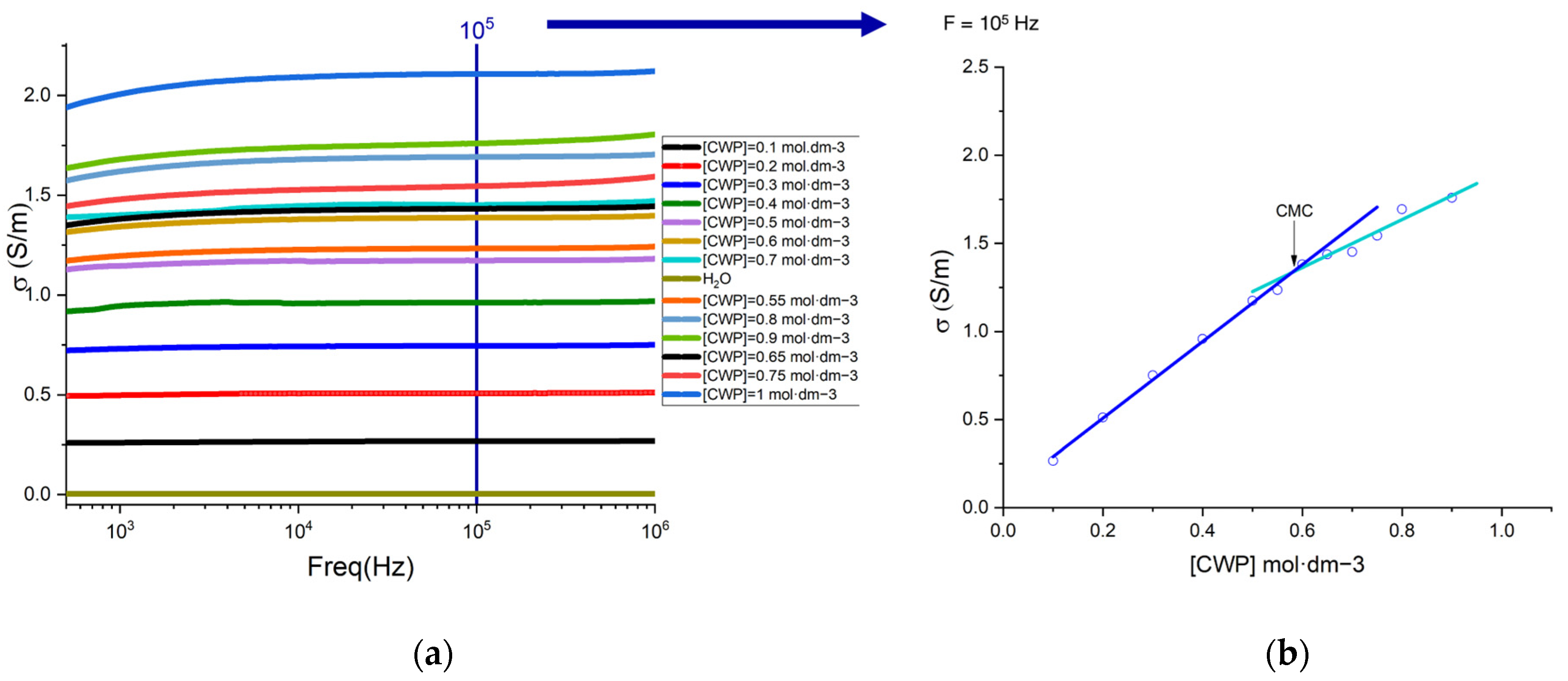
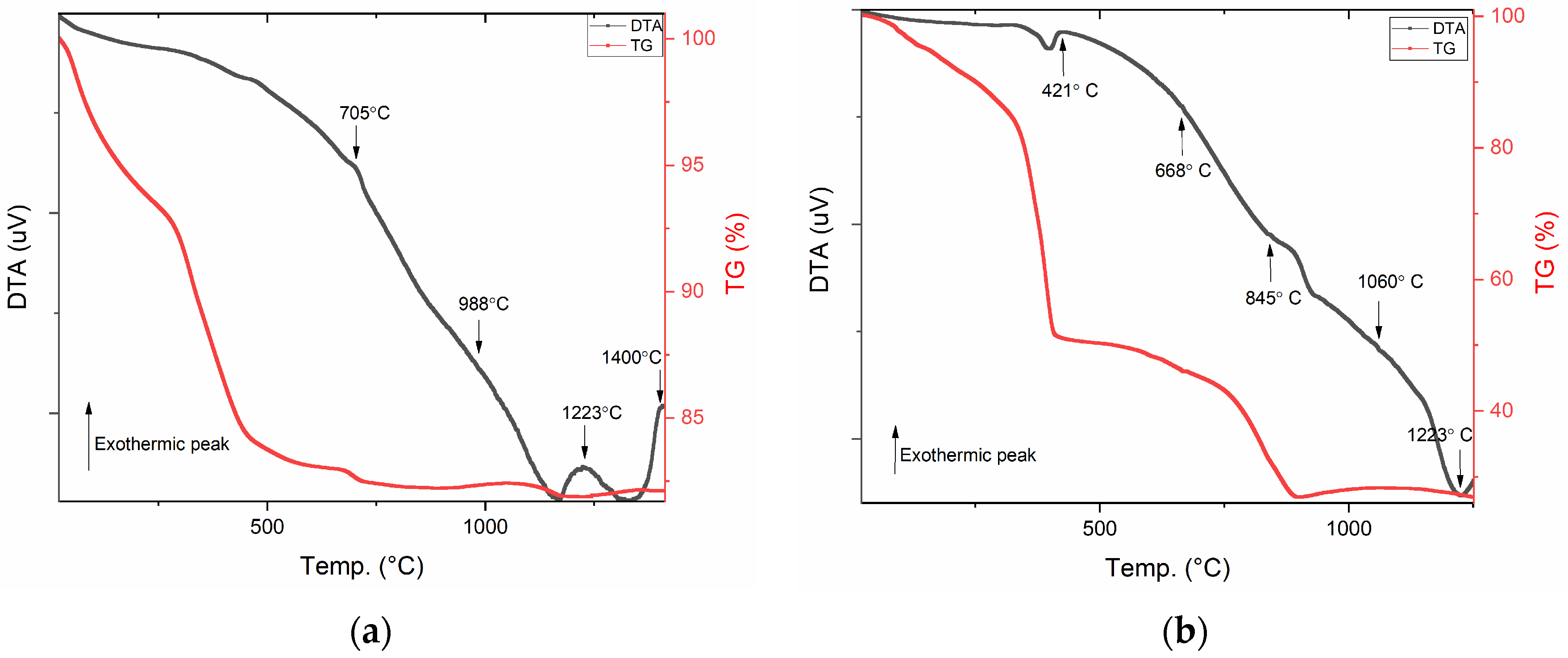

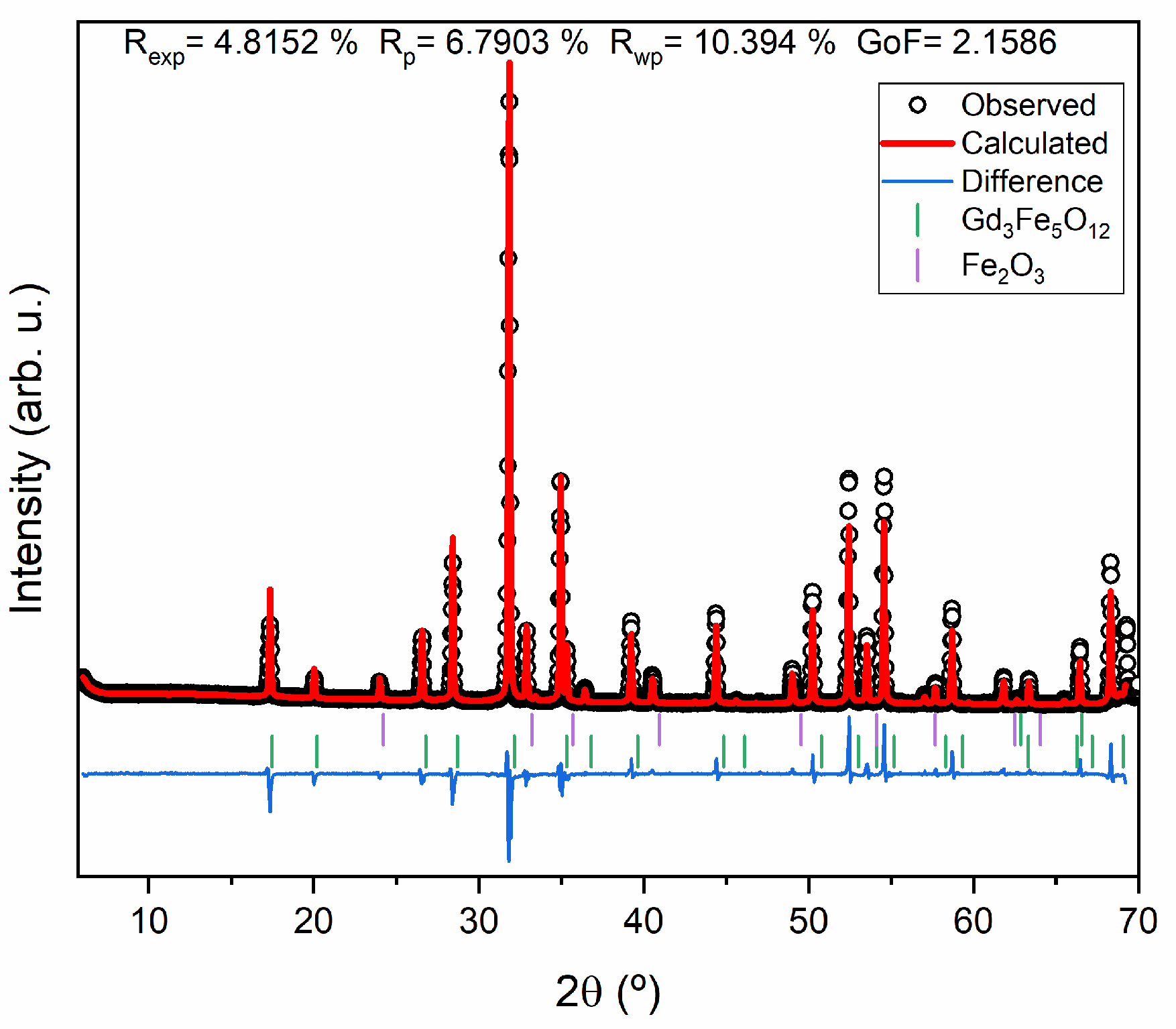
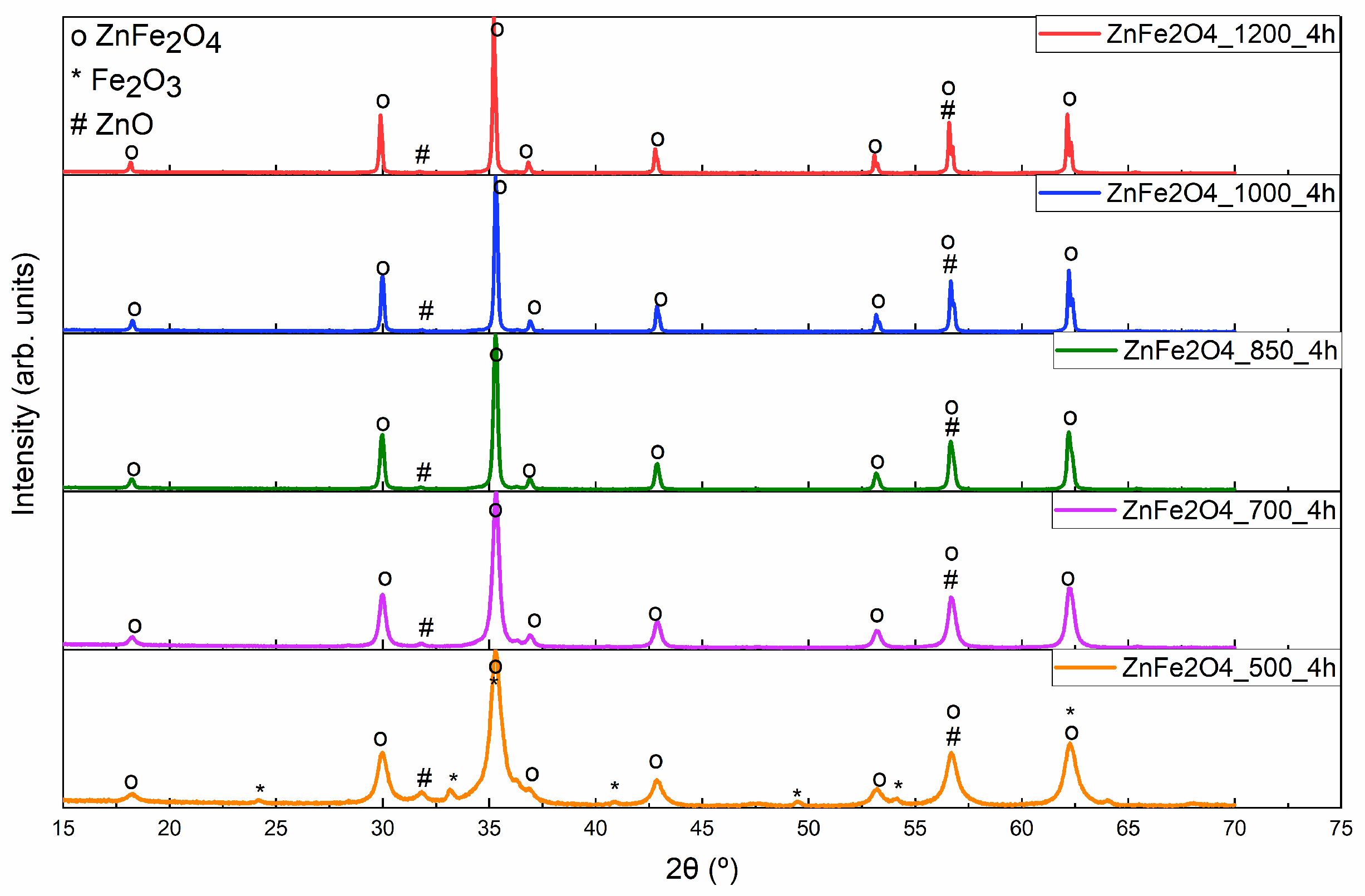
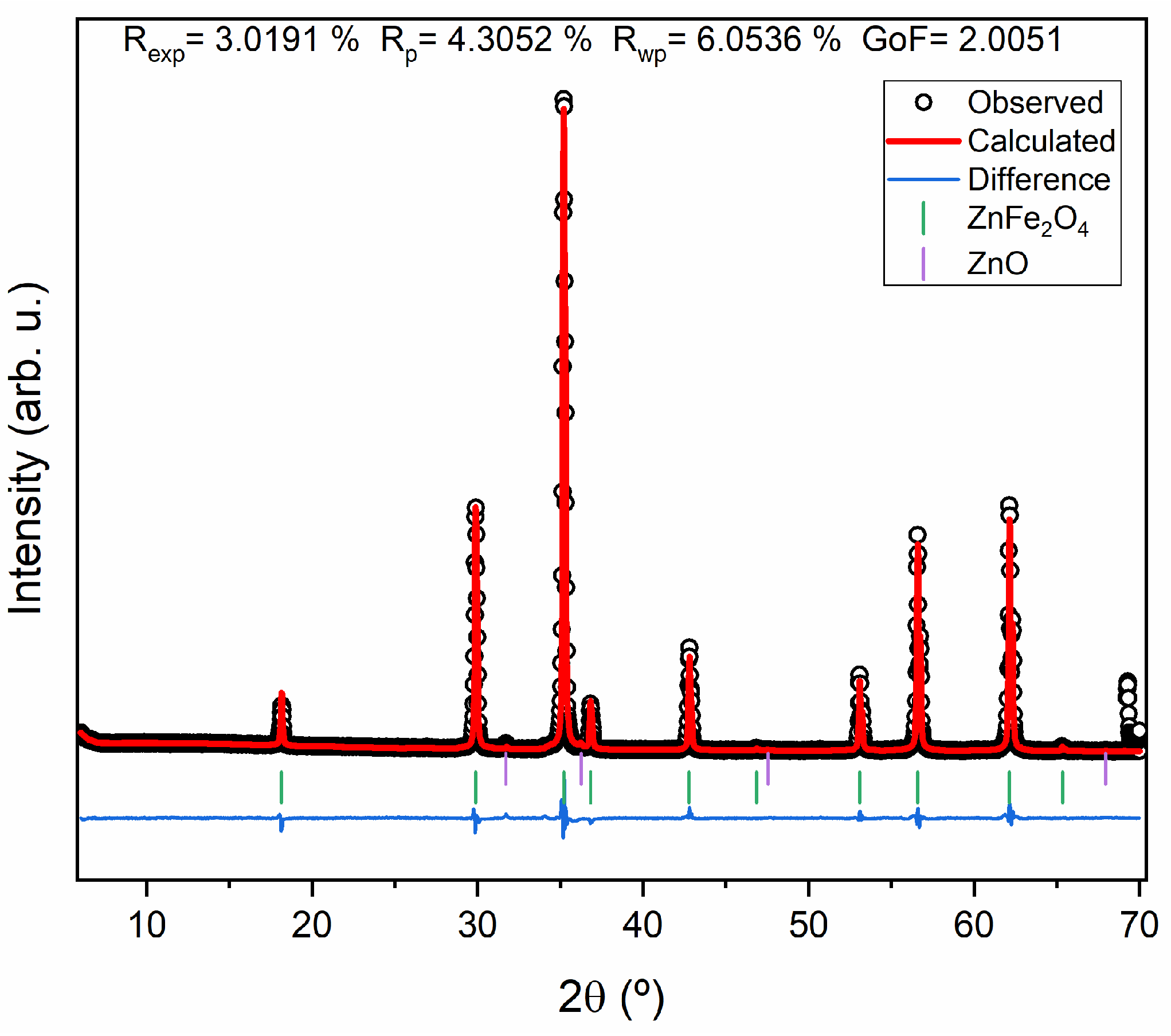
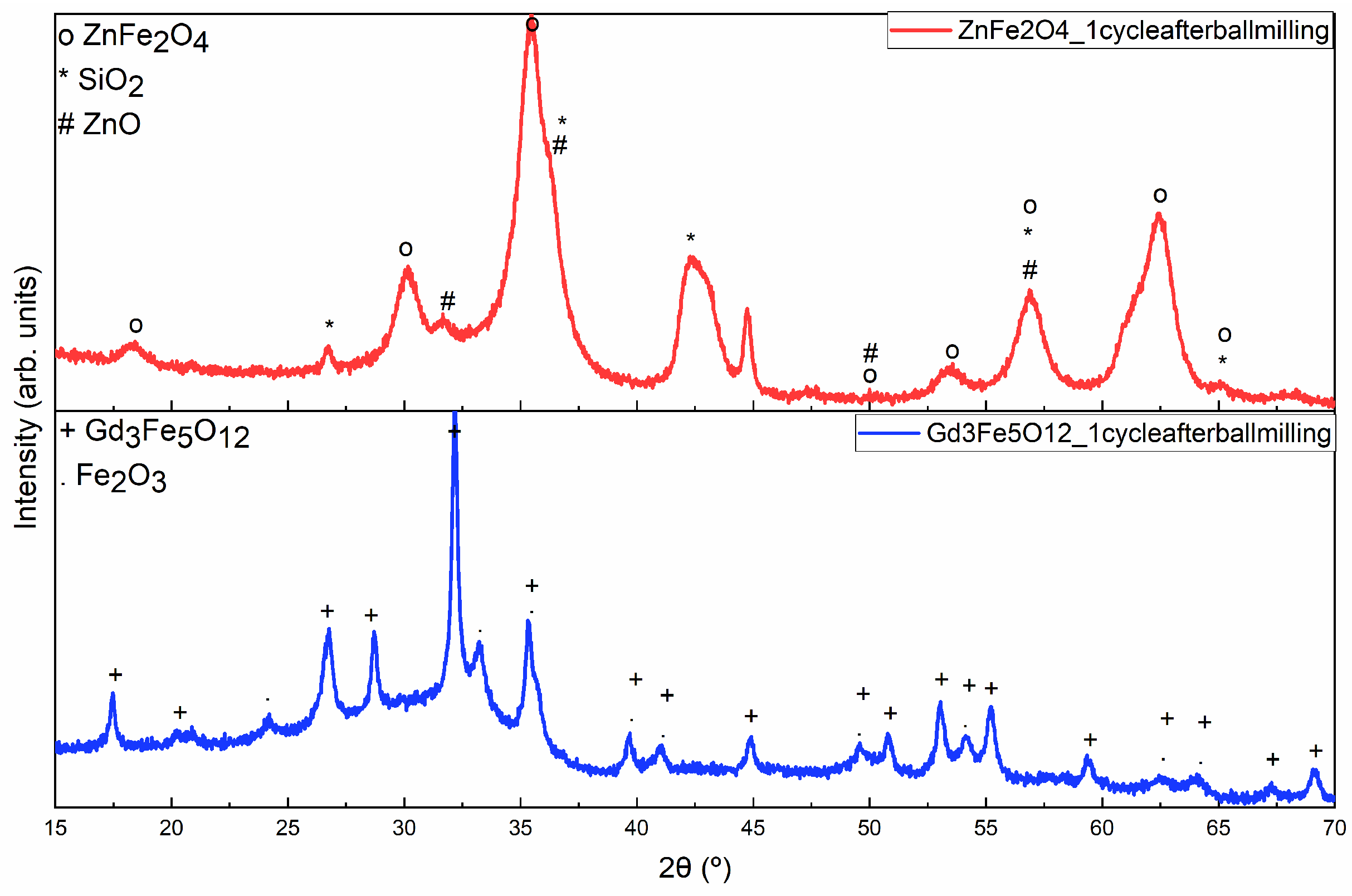

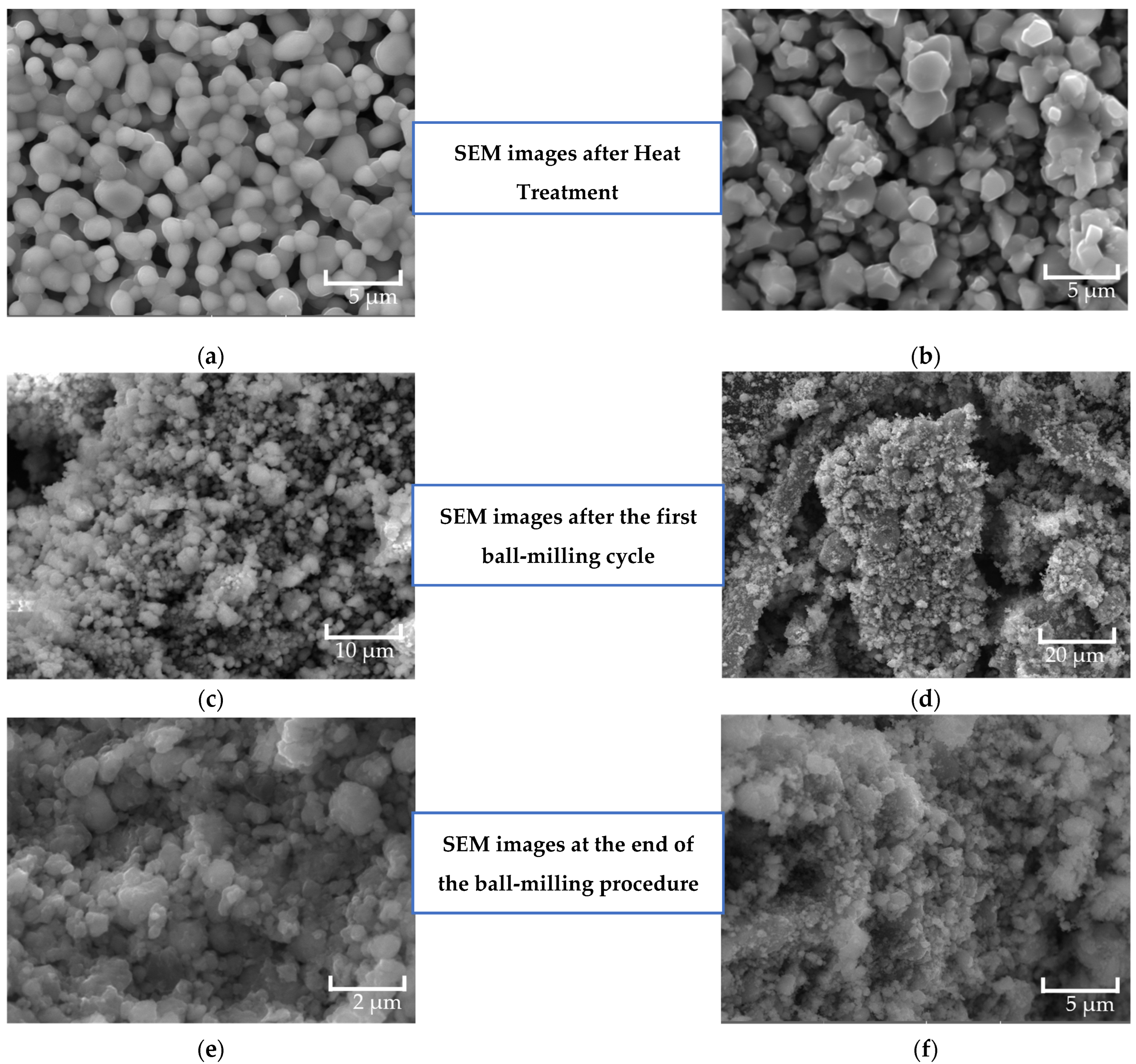
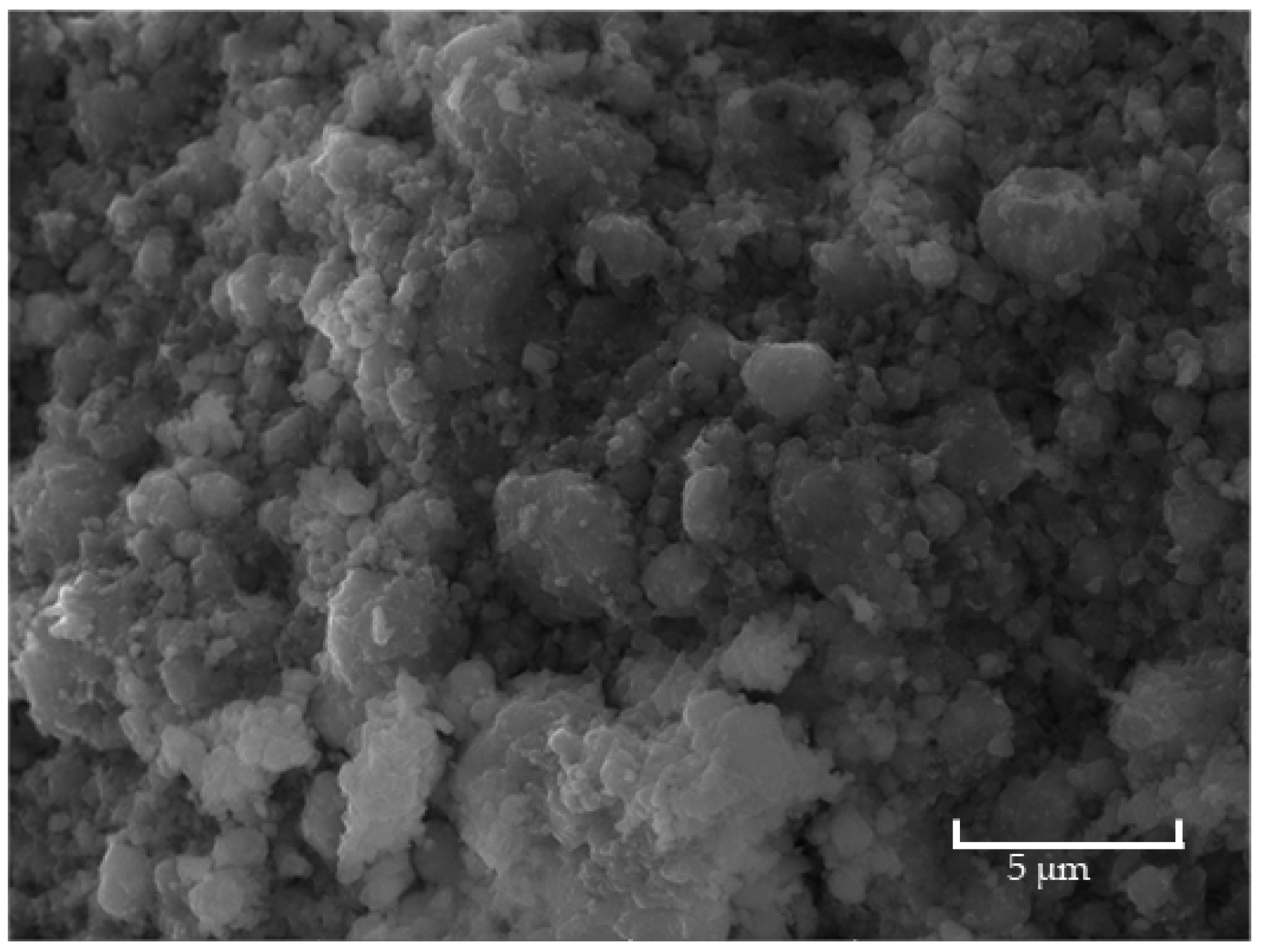
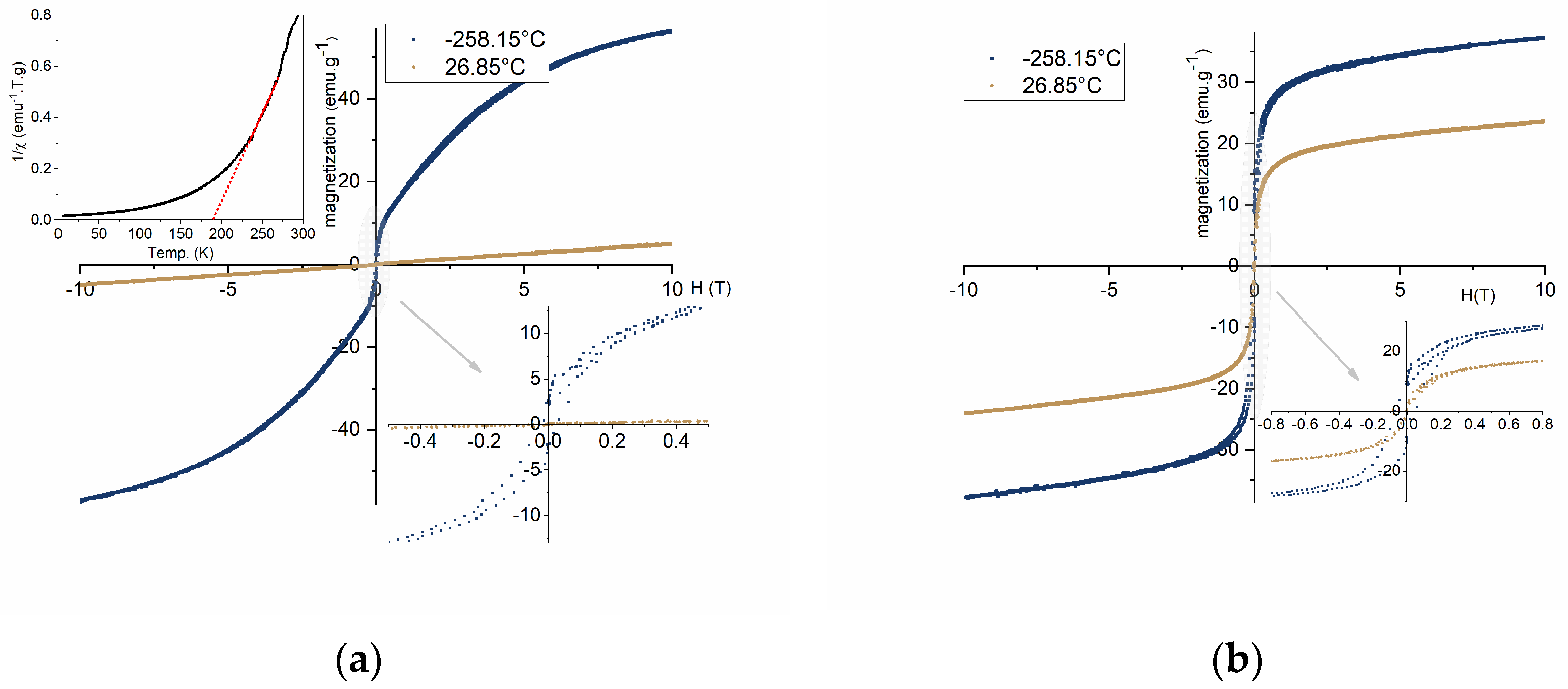

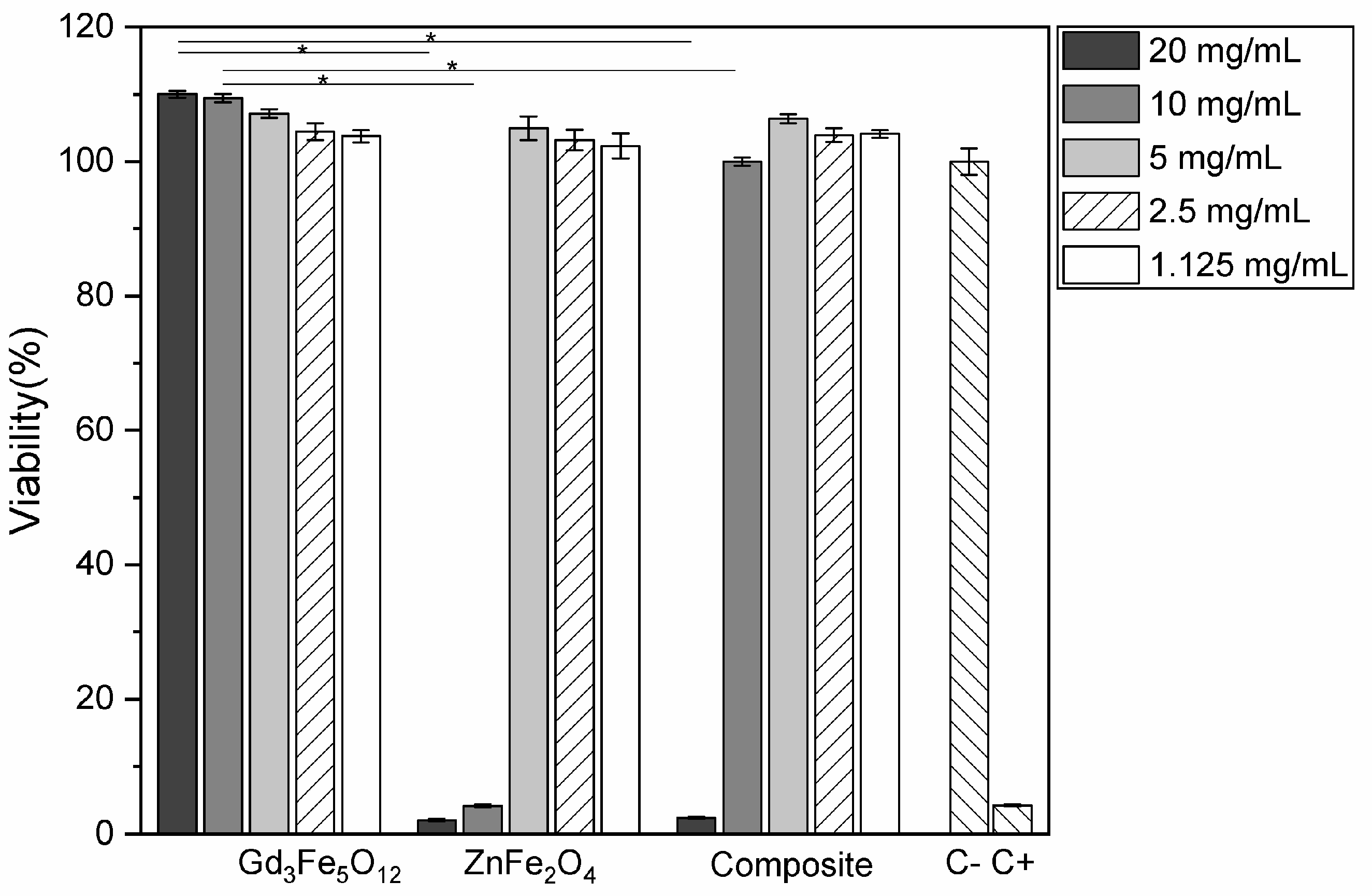
Disclaimer/Publisher’s Note: The statements, opinions and data contained in all publications are solely those of the individual author(s) and contributor(s) and not of MDPI and/or the editor(s). MDPI and/or the editor(s) disclaim responsibility for any injury to people or property resulting from any ideas, methods, instructions or products referred to in the content. |
© 2024 by the authors. Licensee MDPI, Basel, Switzerland. This article is an open access article distributed under the terms and conditions of the Creative Commons Attribution (CC BY) license (https://creativecommons.org/licenses/by/4.0/).
Share and Cite
Costa, B.; Carvalho, J.; Gavinho, S.; Vieira, T.; Silva, J.C.; Soares, P.I.P.; Valente, M.A.; Soreto, S.; Graça, M. Preparation and Characterization of Zinc Ferrite and Gadolinium Iron Garnet Composite for Biomagnetic Applications. Materials 2024, 17, 2949. https://doi.org/10.3390/ma17122949
Costa B, Carvalho J, Gavinho S, Vieira T, Silva JC, Soares PIP, Valente MA, Soreto S, Graça M. Preparation and Characterization of Zinc Ferrite and Gadolinium Iron Garnet Composite for Biomagnetic Applications. Materials. 2024; 17(12):2949. https://doi.org/10.3390/ma17122949
Chicago/Turabian StyleCosta, Bárbara, João Carvalho, Sílvia Gavinho, Tânia Vieira, Jorge Carvalho Silva, Paula I. P. Soares, Manuel A. Valente, Sílvia Soreto, and Manuel Graça. 2024. "Preparation and Characterization of Zinc Ferrite and Gadolinium Iron Garnet Composite for Biomagnetic Applications" Materials 17, no. 12: 2949. https://doi.org/10.3390/ma17122949







